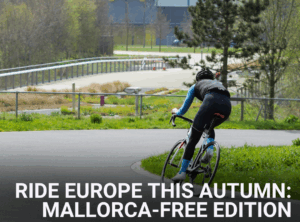Rolling resistance vs puncture protection
One of the unsung joys of riding between the months of May and August is the ability to put your nice, summer tyres on. Removing your winter rubber in summer is akin to removing your shoes at the end of a long day. Bliss. That first ride feels so smooth and fast, perhaps you’ve even treated yourself and popped a pair of latex tubes in (or gone lighter on the tubeless sealant). This feels great until you hear that all too familiar hiss – oh dear. Puncture. The thing is, there’s a balance to be struck between rolling resistance and puncture protection. Faster rolling tyres will go flat more easily but they make riding that much more enjoyable. Luckily for you, we’re here to talk you through the problem and help you make the right choice.

What is rolling resistance?
Rolling resistance is a relatively simple concept. As we ride, our tyres generate heat as they rub along the floor. This heat generated is energy. Energy that’s being used on something other than us being propelled forward. Another large component of rolling resistance is the tyres deforming as they make contact with the ground and then reforming. The energy of deformation is larger than the energy of recovery and slowly this energy is lost over time. For example, we put some given amount of energy per second (this energy is what we see when we measure power) into our bike. This energy has to go somewhere (as we know it cannot be created or destroyed) and as cyclists we want as much of this energy as possible to go into moving us along the road. Some (most) of this energy actually goes to us battling air resistance, some goes into us battling with gravity and then some on frictional forces. One of these frictional forces is rolling resistance. This can account for up to 20% of your overall resistance, so it’s quite a significant amount.

Other than new tyres, can we do anything to reduce it?
Yes, yes we can. The material of our inner tubes can make a difference as can their thickness. Presumably this is because the energy costs associated with the deformation and recovery of the tube are lower. Try a latex tube instead of butyl for example and you’ll be able to feel the difference. On top of this, our tyre pressure can also play a ‘roll’ (sorry). Lower pressures can reduce rolling resistance, to a point – obviously a flat tyre is not fast. This may take some experimentation on your end and also changes depending on the state of the road. Generally, lower pressures are faster on bumpier surfaces as the tyre is able to absorb a bit more of the road. Bouncing around in between imperfections in the road surface is not fast – despite the fact it can feel quite quick.
How can I calculate my rolling resistance?
You can’t really, not without a big fancy jig that measures other stuff and figures out how much energy you’re losing to rolling along. Fear not though, you can find other people who have done it for you which will help you make a more informed tyre choice. My favourite, most reliable, location for this data is Aerocoach. They publish a large amount of rolling resistance data here that can help you choose the right set of tyres.
What level of tradeoff is right for me?
Ultimately this will depend on what you’re doing. If you’re racing, faster is better (usually) though, as we saw on stage five of the Tour de France this year, punctures have the ability to ruin a race. The rolling resistance and puncture protection tradeoff is different for a ten mile time trial on a dual carriageway than it is for a 130km road race on less than perfect country roads. For a short race on a consistently good surface, go all in for a fast tyre. For a road race or sportive on country roads, go for a more sturdy racing tyre. If you’re lucky enough to be buying a tyre just for training – go for puncture protection.
I want a puncture resistant tyre for training and also a fast tyre for racing, what should I get?
The default choice in this aspect five years ago was the Gatorskin from Continental for training. This is no longer the best choice, my favourite winter tyre is the Pirelli Cinturato Velo TLR. These are tubeless ready and don’t roll horribly. I used them last winter for the last few months and they were great. The best fast tyres for racing, in my opinion, are Vittoria Corsa Speed TLRs. These test very fast according to Aerocoach and have some (very modest) puncture protecting qualities!

I want a middle of the road tyre for all summer, what are my options?
If you want a tyre that’ll do it all – training and racing, you’re not alone. Everyone you ask will say pretty much the same thing – Conti GP5000. This is a solid choice and they’re some of my favourite tyres. They roll fairly fast and don’t puncture too much. Away from this obvious choice there’s also the Specialized Turbo Cotton, a tyre I have ridden as a winter tyre (despite this not being its primary purpose) and actually didn’t puncture too often and rolls fast. I’d certainly recommend them.
Conclusion
Given that up to one fifth of our energy is going into overcoming rolling resistance it’s definitely a factor worth considering. The main key in selecting the right tyre breaks down into two steps. Firstly, know what you want. Figure out which is worse – being slower or getting a puncture. Generally, this scales with length of race and puncture probability. Once you’ve done that, get informed – make sure you’re not buying a slow tyre for racing by informing yourself on rolling resistance data online. Good luck making the right choice.










